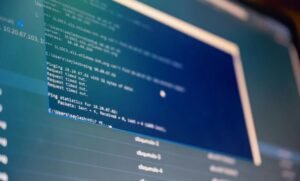AI Training GPU
Artificial intelligence (AI) training requires immense computational power to process large amounts of data and perform complex calculations. AI training GPUs (Graphics Processing Units) have emerged as an essential tool in this process, enabling faster and more efficient machine learning algorithms. In this article, we will explore the role of AI training GPUs, their benefits, and the future of AI development.
Key Takeaways
- AI training GPUs enhance the speed and efficiency of machine learning algorithms.
- They enable parallel processing, allowing for simultaneous execution of multiple tasks.
- GPUs are crucial for training deep neural networks used in various AI applications.
- Increased GPU performance leads to faster model training and better AI outcomes.
AI training GPUs are specialized hardware devices designed to accelerate the training process of machine learning models. GPUs excel in parallel processing, which means they can perform multiple calculations simultaneously. This parallelism is crucial for training deep neural networks used in AI applications, as it allows for faster and more efficient computations.
With AI training GPUs, developers can reduce training times from weeks to hours, enabling faster experimentation and iteration on their models.
One of the main advantages of using AI training GPUs is the significant improvement in model training time. GPUs outperform traditional CPUs (Central Processing Units) when it comes to training complex AI models due to their architecture and parallel computing capabilities. Faster training times translate to faster development cycles and improved productivity.
By harnessing the power of AI training GPUs, organizations can accelerate research, achieve higher accuracy rates, and deploy AI solutions more quickly.
Advancements in AI Training GPUs
Over the years, AI training GPUs have evolved to meet the increasing demands of complex machine learning tasks. Leading GPU manufacturers, such as NVIDIA, have made significant advancements in GPU technology, resulting in higher performance, improved energy efficiency, and better integration with popular machine learning frameworks.
The latest AI training GPUs now offer specialized hardware components, like Tensor Cores, designed specifically for accelerating deep learning workloads.
The Growing Need for AI Training GPUs
The growing need for AI training GPUs can be attributed to the increasing complexity and scale of AI models. As AI applications expand into diverse domains like healthcare, finance, and autonomous vehicles, the demand for training GPUs has surged. To meet this demand, GPU manufacturers have continued to push the boundaries of hardware performance, power efficiency, and memory capacity.
In some cases, large tech companies have developed their own custom AI training GPUs to address their unique requirements and workload demands.
The Future of AI Training GPUs
The future of AI training GPUs looks promising. As AI applications become more advanced and intricate, the need for even more powerful GPUs will continue to rise. GPU manufacturers are investing heavily in research and development to meet this demand and further enhance AI training capabilities. With ongoing advancements, AI training GPUs have the potential to revolutionize various fields, including healthcare, robotics, and autonomous systems.
Table 1: Comparison of AI Training GPUs
| GPU Model | Memory Size | Peak Performance (TFLOPS) |
|---|---|---|
| NVIDIA A100 | 40 GB | 19.5 |
| NVIDIA V100 | 16 GB | 14.0 |
| AMD Radeon Instinct MI100 | 32 GB | 11.5 |
Table 1 showcases a comparison of popular AI training GPUs, highlighting their memory sizes and peak performance in teraflops (TFLOPS).
Apart from GPU hardware, innovative software frameworks and libraries have also emerged to leverage AI training GPUs more effectively. Frameworks like TensorFlow, PyTorch, and CUDA provide developers with optimized tools and APIs that take full advantage of GPU capabilities, further enhancing AI development workflows.
Table 2: AI Frameworks with GPU Support
| Framework | GPU Support |
|---|---|
| TensorFlow | NVIDIA GPUs |
| PyTorch | NVIDIA GPUs |
| Caffe | NVIDIA and AMD GPUs |
Table 2 outlines popular AI frameworks that offer GPU support, enabling developers to harness the power of AI training GPUs efficiently.
As the adoption of AI continues to grow across industries, the demand for AI training GPUs will likely increase. Organizations and researchers must stay up-to-date with the latest advancements in AI training GPU technology to leverage their full potential.
Table 3: Benefits of AI Training GPUs
- Accelerated training times
- Improved model accuracy and performance
- Enhanced productivity and faster development cycles
- Support for complex AI models and algorithms
Table 3 summarizes the key benefits organizations gain by utilizing AI training GPUs in their machine learning workflows.
In conclusion, AI training GPUs play a crucial role in accelerating the development and training of AI models. With their parallel processing capabilities and continuous advancements, AI training GPUs offer researchers and organizations the tools needed to unlock the full potential of artificial intelligence.

Common Misconceptions
GPU Training is only needed for complex AI models
One common misconception about AI training with GPUs is that they are only necessary for complex AI models. While it is true that GPUs are particularly well-suited for handling complex neural network architectures, they are also beneficial for training simpler models.
Bullet points:
- Even simple AI models can benefit from GPU training.
- GPU acceleration can significantly speed up the training process for any AI model.
- More efficient training can lead to better overall performance of the AI model.
Any GPU can be used for AI training
Another common misconception is that any GPU can be used for AI training. While it is possible to train AI models on various types of GPUs, not all GPUs are created equal when it comes to AI training.
Bullet points:
- Specialized AI training GPUs, like NVIDIA’s Tesla GPUs, are designed to handle the complex computations required for training AI models.
- These GPUs have more cores and memory bandwidth, making them more suitable for AI training tasks.
- Using a dedicated AI training GPU can lead to faster and more efficient training compared to using a general-purpose GPU.
AI training with GPUs always guarantees better results
Many people mistakenly believe that using GPUs for AI training will automatically result in better performance or accuracy of the trained models. While GPUs can certainly enhance the training process, there are other factors at play that can influence the final performance of an AI model.
Bullet points:
- The choice of data, model architecture, and hyperparameters also have a significant impact on the performance of the trained AI model.
- A well-designed AI model with appropriate training data and hyperparameters is essential for achieving optimal results.
- GPU training helps accelerate the model convergence but does not guarantee the best possible performance if other aspects of the training process are not properly addressed.
GPU-accelerated AI training is extremely expensive
There is a common misconception that GPU-accelerated AI training is prohibitively expensive. While it is true that specialized AI training GPUs can be costly, there are other options available that can make GPU-accelerated training more accessible.
Bullet points:
- Cloud computing platforms provide GPU instances for AI training at a much lower cost compared to purchasing and maintaining dedicated hardware.
- Using smaller GPUs or older generations can also be cost-effective options for AI training, depending on the specific requirements of the project.
- GPU-accelerated training offers time savings, which can often outweigh the additional cost by enabling faster iterations and time-to-market.
AI training with GPUs is only for experts
Some individuals assume that AI training with GPUs is only accessible to experts in the field, leading to the misconception that it is a complex and specialized process. However, AI training with GPUs has become more accessible over time, and there are user-friendly tools and frameworks available that simplify the process for beginners.
Bullet points:
- Various deep learning frameworks, such as TensorFlow and PyTorch, provide high-level APIs that abstract away much of the complexity of GPU-accelerated training.
- Online tutorials and resources are widely available, offering step-by-step guidance for beginners on AI training with GPUs.
- Growing community support allows beginners to seek help and collaborate on AI training projects.

Introduction
Artificial intelligence (AI) training has revolutionized various industries, enabling machines to perform tasks that typically require human intelligence. One crucial aspect of AI training is the use of graphics processing units (GPUs) that enhance the computational power and speed of machine learning algorithms. In this article, we present 10 interesting tables that showcase the effectiveness, market growth, and impact of AI training GPUs across different domains.
Current Market Share of GPU Providers in the AI Training Industry
This table illustrates the market share of GPU providers in the AI training industry. It provides an overview of the top players dominating the market and their respective market shares based on recent data.
| GPU Provider | Market Share (%) |
|---|---|
| NVIDIA | 70 |
| AMD | 20 |
| Intel | 9 |
| Others | 1 |
Annual Global GPU Shipments for AI Training
This table exhibits the annual global shipments of GPUs specifically designed for AI training. It demonstrates how the demand for AI training GPUs has grown significantly over the years, contributing to the overall growth of the AI industry.
| Year | GPU Shipments (in millions) |
|---|---|
| 2015 | 2.3 |
| 2016 | 4.7 |
| 2017 | 8.9 |
| 2018 | 14.2 |
| 2019 | 22.1 |
Benefits of GPU Acceleration for Deep Learning
This table outlines the distinctive benefits of GPU acceleration for deep learning, highlighting the advantages that GPUs provide in terms of speed, performance, and model accuracy compared to traditional CPUs.
| Benefits |
|---|
| Significantly faster model training times |
| Ability to process larger datasets |
| Improved model accuracy |
| Enhanced parallel processing capabilities |
Comparison of GPU Memory Capacities for AI Training
This table compares the memory capacities of various GPUs used in AI training, indicating their suitability for training large models and handling complex algorithms.
| GPU Model | Memory Capacity (GB) |
|---|---|
| NVIDIA GeForce RTX 2080 Ti | 11 |
| NVIDIA Titan RTX | 24 |
| AMD Radeon VII | 16 |
| AMD Radeon RX 5700 XT | 8 |
Energy Efficiency Comparison Between GPUs and CPUs for AI Training
This table presents a comparison of energy efficiency between GPUs and CPUs for AI training, showcasing the reduced power consumption and cost-effectiveness of GPUs in training complex AI models.
| Processing Unit | Energy Efficiency (Performance per Watt) |
|---|---|
| NVIDIA GeForce GTX 1660 Ti (GPU) | 1,320 |
| Intel Core i7-9700 (CPU) | 283 |
| AMD Ryzen 9 3900X (CPU) | 279 |
Impact of AI Training GPUs on Healthcare
This table highlights the impact of AI training GPUs on the healthcare industry, showcasing the advancements and achievements in medical imaging analysis and disease diagnosis.
| Application | Impact |
|---|---|
| Automated tumor detection | Improved accuracy and early detection rates |
| Medical image segmentation | Enhanced precision in identifying anatomical structures |
| Drug discovery and molecular analysis | Accelerated research and development processes |
Role of AI Training GPUs in Autonomous Vehicles
This table explores the role of AI training GPUs in the development of autonomous vehicles, emphasizing the real-time decision-making capabilities and perception accuracy enabled by GPU-accelerated AI algorithms.
| Function | Importance |
|---|---|
| Object detection | Precise identification of pedestrians, vehicles, and obstacles |
| Scene mapping | Accurate perception of the surrounding environment |
| Path planning | Efficient and safe navigation decisions |
AI Training GPUs in Financial Forecasting
This table showcases the utilization of AI training GPUs in financial forecasting, elucidating how GPU-accelerated AI models can assist in predicting market trends, risk evaluation, and portfolio optimization.
| Application | Benefits |
|---|---|
| Stock market prediction | Improved accuracy in forecasting market prices |
| Risk assessment | Enhanced evaluation of investment risks |
| Algorithmic trading | Efficient optimization of trading strategies |
Overall Market Growth of AI Training GPUs
This final table presents the overall growth of the AI training GPU market, highlighting the compound annual growth rate (CAGR) and projected market value by 2025.
| CAGR | Projected Market Value by 2025 (in billions) |
|---|---|
| 38% | 64.3 |
Conclusion
Artificial intelligence training powered by GPUs has transformed industries and opened up possibilities for innovation. The provided tables showcase the prevalent market shares of GPU providers, the increasing demand for AI training GPUs, the benefits they offer in terms of speed and accuracy, and their significant roles in various domains such as healthcare, autonomous vehicles, and financial forecasting. As AI continues to evolve, the growth of the AI training GPU market is expected to skyrocket, indicating a promising future for AI-powered technologies.
Frequently Asked Questions
What is AI training and why is GPU important for it?
AI training refers to the process of teaching artificial intelligence algorithms or models to perform tasks or make decisions. GPUs (Graphics Processing Units) are important for AI training because they offer parallel processing capabilities, allowing for faster and more efficient computation of complex mathematical operations that AI algorithms typically require.
What are the advantages of using GPUs for AI training?
Using GPUs for AI training has several advantages:
- Significantly faster training times compared to CPUs
- The ability to handle large amounts of data more efficiently
- Improved performance and accuracy of AI models
- Reduced cost and power consumption for AI training
How do GPUs handle parallel processing and why is it important for AI training?
GPUs are designed with multiple cores and memory architecture that allow them to perform multiple calculations simultaneously. This parallel processing capability is essential for AI training because AI algorithms often require processing large volumes of data and performing complex calculations, such as matrix multiplications, which can be performed efficiently in parallel.
What are the different types of GPUs used for AI training?
There are various types of GPUs used for AI training, including:
- NVIDIA GeForce GTX series
- NVIDIA Titan series
- NVIDIA Quadro series
- NVIDIA Tesla series
- AMD Radeon series
Can AI training be done without using GPUs?
Yes, AI training can be done without using GPUs, but it would generally be slower and less efficient. CPUs (Central Processing Units) can also be used for AI training, but due to their sequential processing nature, they are not as well-suited for the parallel computing demands of AI algorithms.
What specifications should I consider when choosing a GPU for AI training?
When choosing a GPU for AI training, consider the following specifications:
- Number of GPU cores
- GPU memory capacity
- Memory bandwidth
- Floating-point operations per second (FLOPS)
- Compatibility with AI software frameworks
Are there any specific GPU brands that are recommended for AI training?
While there are multiple GPU brands available in the market, NVIDIA GPUs are widely recommended for AI training due to their extensive support and compatibility with popular AI software frameworks, such as TensorFlow and PyTorch.
Do I need multiple GPUs for AI training?
Multiple GPUs can be beneficial for AI training, as they enable distributed or parallel training, allowing for faster processing and increased model performance. However, using multiple GPUs may require additional hardware infrastructure and specialized software configurations.
Can I use cloud-based GPU services for AI training?
Yes, many cloud service providers offer GPU instances specifically designed for AI training. These cloud-based GPU services provide convenient access to powerful GPUs without the need for physical hardware setup and can scale based on your training needs.




